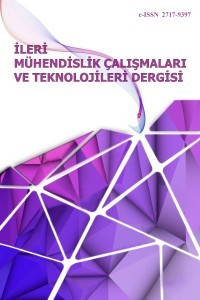Geri Çekildi : TiO2 Katalizörü Kullanılarak Fotokatalitik Yöntemle Reactive Black 5 Boyarın Atık Sudan Giderimi
TiO2, Fotokatalitik, Teaktif Black5, Katalizör, Adsorpsiyon
Geri Çekildi : Removal of Reactive Black 5 Dye from Waste Water by Photocatalytic Method Using TiO2 Catalyst
TiO2, Photocatalitic, Reactive black5, Catalyst, Adsorption,
___
- Couto S.R. (2009). Dye removal by immobilised fungi, Biotechnology Advances, 27(3), 227–235.
- Crini G., Badot P.M. (2008). Application of chitosan, a natural aminopolysaccharide, for dye removal from aqueous solutions by adsorption processes using batch studies: A review of recent literature, Progress in Polymer Science, 33(4), 399–447.
- Daneshvar N., Salari D., Khataee A. (2003). Photocatalytic degradation of azo dye acid red 14 in water: investigation of the effect of operational parameters, Journal of Photochemistry and Photobiology A: Chemistry, 157(1), 111–116.
- Georgiou D., Melidis P., Aivasidis A., Gimouhopoulos K. Degradation of azo-reactive dyes by ultraviolet radiation in the presence of hydrogen peroxide, Dyes and Pigments, 52(2), 69–78.
- Ghaedi M., Hajjati S., Mahmudi Z., Tyagi I., Agarwal S., Maity A., Gupta V. (2015). Modeling of competitive ultrasonic assisted removal of the dyes – Methylene blue and Safranin-O using Fe3O4 nanoparticles, Chemical Engineering Journal, 268, 28–37.
- Guettaï N., Amar H.A. (2005). Photocatalytic oxidation of methyl orange in presence of titanium dioxide in aqueous suspension. Part I: Parametric study, Desalination, 185(1-3), 427–437.
- Hamaloğlu K.Ö., Sağ E., Kip Ç., Şenlik E., Kaya B.S., Tuncel A. (2019). Magnetic-porous microspheres with synergistic catalytic activity of small-sized gold nanoparticles and titania matrix, Frontiers of Chemical Science and Engineering, 13(3), 574-585.
- Kaneko M., Okura I. (2011). Photocatalysis: science and technology. Tokyo: Kodansha.
- Lei X.F., Xue X.X., Yang H.H. (2014). Preparation and characterization of Ag-doped TiO2 nanomaterials and their photocatalytic reduction of Cr(VI) under visible ligh Applied Surface Science, 321, 396-403.
- Li X., Dai X., Takahashi J., Li N., Jin J., Dai L., Dong B. (2014). New insight into chemical changes of dissolved organic matter during anaerobic digestion of dewatered sewage sludge using EEM-PARAFAC and two-dimensional FTIR correlation spectroscopy, Bioresource Technology, 159, 412-420.
- Moradi M., Ghanbari F., Manshouri M., Angali K.A. (2015). Photocatalytic degradation of azo dye using nano-ZrO2/UV/Persulfate: Response surface modeling and optimization, Korean Journal of Chemical Engineering, 33(2), 539–546.
- Nandhini N., Rajeshkumar S., Mythili S. (2019). The possible mechanism of eco-friendly synthesized nanoparticles on hazardous dyes degradation, Biocatalysis and Agricultural Biotechnology, 19, 101138.
- Natarajan S., Bajaj H.C., Tayade R.J. (2018). Recent advances based on the synergetic effect of adsorption for removal of dyes from waste water using photocatalytic process, Journal of Environmental Sciences, 65, 201–222.
- Neppolian B., Sakthivel S., Arabindoo B., Palanichamy M., Murugesan V. (1999). Degradation of textile dye by solar light using TiO2 and ZnO photocatalysts, Journal of Environmental Science and Health, Part A, 34(9), 1829-1838.
- Ozdes D., Duran C., Senturk H.B. (2011). Adsorptive removal of Cd(II) and Pb(II) ions from aqueous solutions by using Turkish illitic clay, Journal of Environmental Management, 92, 3082-3090.
- Özyonar F., Karagözoğlu B. (2012). Elektrokoagülasyon prosesi ile tekstil sanayi atiksuyunun aritimi, Erciyes Üniversitesi Fen Bilimleri Enstitüsü Dergisi, 28(1), 29-37.
- Pan H., Feng J., He G.X., Cerniglia C.E., Chen H. (2012). Evaluation of impact of exposure of Sudan azo dyes and their metabolites on human intestinal bacteria, Anaerobe, 18(4), 445–453.
- Petcu A.R., Lazar C.A., Rogozea E.A., Olteanu N.L., Meghea A., Mihaly M. (2016). Nonionic microemulsion systems applied for removal of ionic dyes mixtures from textile industry wastewaters, Separation and Purification Technology, 158, 155–159.
- Ram C., Pareek R.K., Singh V. (2012). Photocatalytic degradation of textile dye by using titanium dioxide nanocatalyst, International Journal of Theoretical and Applied Sciences, 4(2), 82–88.
- Sarayu K., Sandhya S. (2012). Current technologies for biological treatment of textile wastewater-a review, Applied Biochemical Biotechnolgy, 167(3), 645-661.
- Shamraiz U., Hussain R.A., Badshah A., Raza B., Saba S. (2016). Functional metal sulfides and selenides for the removal of hazardous dyes from Water, Journal of Photochemistry and Photobiology B: Biology, 159, 33–41.
- Sharaf El-Deen S. E.A., Zhang F.S. (2016). Immobilisation of TiO2-nanoparticles on sewage sludge and their adsorption for cadmium removal from aqueous solutions, Journal of Experimental Nanoscience, 11(4), 239-258.
- Souza R.P., Freitas T.K., Domingues F.S., Pezoti O., Ambrosio E., Ferrari-Lima A.M., Garcia J.C. (2016). Photocatalytic activity of TiO2, ZnO and Nb2O5 applied to degradation of textile wastewater, Journal of Photochemistry and Photobiology A: Chemistry, 329, 9-17.
- Vasei M., Das P., Cherfouth H., Marsan B., Claverie J.P. (2014). TiO2@C core-shell nanoparticles formed by polymeric nano-encapsulation, Frontiers in Chemistry, 2, 1-9.
- Verma A.K., Dash R.R., Bhunia P. (2012). A review on chemical coagulation/flocculation technologies for removal of colour from textile wastewaters. Journal of Environmental Management, 93(1), 154-168.
- Zhou Y., Lu J., Zhou Y., Liu Y. (2019). Recent advances for dyes removal using novel adsorbents: A review, Environmental Pollution, 252, 352–365.
- Zhu X., Yuan C., Bao Y., Yang J., Wu Y. (2005). Photocatalytic degradation of pesticide pyridaben on TiO2 particles, Journal of Molecular Catalysis A: Chemical, 229(1-2), 95–105.
- Yayın Aralığı: Yılda 2 Sayı
- Başlangıç: 2020
- Yayıncı: EMRE YILMAZ
İnşaat Mühendisliğinde Yapay Zeka Çalışmaları
Geocell Malzemesinin Özellikleri ve İnşaat Sektöründe Kullanımı
Kaveh DEHGHANİAN, Rukiye ÖNDER
Kokulu Ardıç Odunundan UV Sistem Vernikli Parke Üretimi Denemesi
Ümit AYATA, Nevzat ÇAKICIER, Levent GÜRLEYEN
Yakıt Hücreli Mikro-kojenerasyon Sistemlerinin Evsel Kullanım Açısından İncelenmesi
